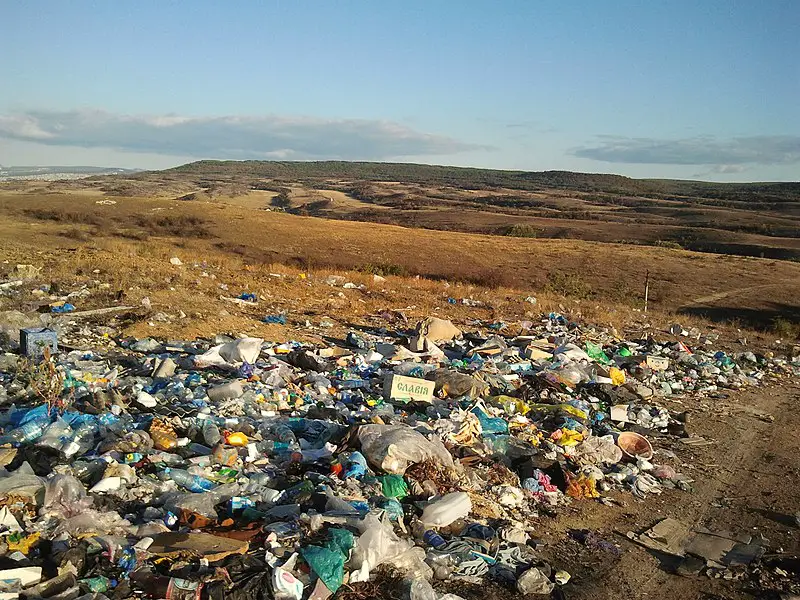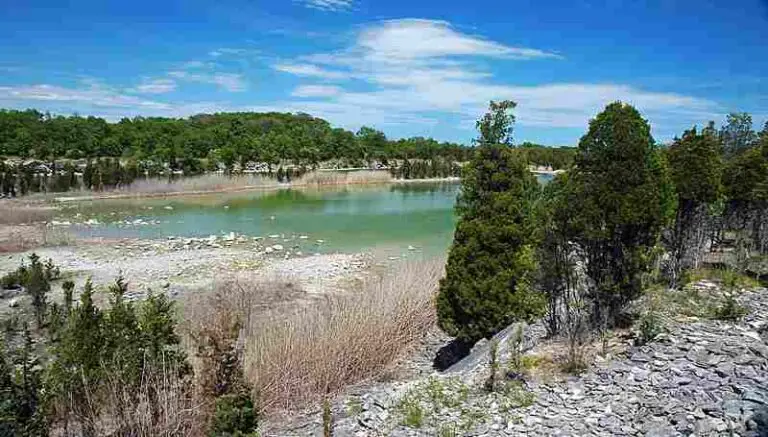Land Pollution Definition and Causes Explained
Land pollution is a process or act whereby surface and near-surface areas on Earth are degraded by hazardous foreign materials. This article discusses land pollution definition and causes, as outlined below;
-Land Pollution Definition: 8 Ways to Define Land Pollution
Land Pollution Definition: 8 Ways to Define Land Pollution
Land pollution is a form of environmental degradation involving a decline in quality of soil and water on the Earth's surface, and slightly beneath the surface.
The above is a basic definition of land pollution, that outlines its concept and scope or rang of influence.
While it can affect water resources and aquatic ecosystems, land pollution is entirely different from water pollution, and can be distinguished into more than on category or type, based on its conditional attributes.
Below is an alternative land pollution definition that makes reference to the types of land pollution as a means by which to further clarify the concept;
Land pollution refers to the introduction of large quantities of harmful materials into a given land area, which may be distinguished into various types including; invasive, non-invasive, industrial, commercial and domestic land pollutions respectively.
The basis used to classify land pollution into its various types listed above include the scope of effect and the cause(s) of pollution. In the land pollution definition below, more light is shed on causes of land pollution as an important concept with regards to the topic;
Land pollution is the act, process and condition of severe contamination on and beneath the Earth's surface, as a result of any of various causes like; deforestation-and-urbanization, inefficient resource-handling (including energy resource-mining, raw material extraction, oil spill), unsustainable agriculture, waste mismanagement, and unsustainable manufacturing [4].
It must be stated that the beneath-surface effect of land pollution is only a result of vertical contaminant-migration from the surface under the influence of gravity; and is observed in cases involving highly-mobile pollutants.
The main pollutants commonly involved in land pollution are; organic compounds from petroleum and biomass (such as sewage), heavy metals like mercury and lead, pharmaceuticals, pesticides, herbicides and fertilizers.
There is a distinction between the causes of land pollution, and the sources of land pollution; where the former refers to all kinds of phenomena that could contribute to land pollution, and the latter refers mainly to factors that act as reserves or backgrounds from which these causative phenomena may arise.
The alternative land pollution definition below provides further clarity to this distinction by listing some of the sources of land pollution;
Land pollution is a phenomenon whereby a given area on the Earth's surface becomes degraded by pollutants from any of various sources including; oil vessels, waste facilities, industrial plants, mine sites, and unsustainable agricultural systems.
Based on the causes and sources, it is possible to outline potential solutions to land pollution. In the alternative land pollution definition below, some of these potential solutions are listed;
Land pollution is a prominent environmental issue involving the introduction of hazardous materials into land areas; and which could be resolved by taking measures such as; sustainable farming practices (like composting), recycling, sustainable manufacturing, afforestation/reforestation [5], and environmental remediation.
The importance of solutions to land pollution can only be appreciated where there is knowledge of the effects of land pollution. Some of these effects are highlighted in the following land pollution definition;
Land pollution is the instantaneous or progressive decline in quality of the environment on the Earth's surface, which can have notable effects like; soil infertility and food insecurity [3], biodiversity-loss for both aquatic and terrestrial species, facilitation of water and air pollutions, human health problems, and facilitation of climatic, lithic and hydrological hazards (like climate change, severe erosion and flooding).
Next, the land pollution definition is outlined to include some examples of land pollution, which can help in understanding the concept;
Land pollution is a process of deterioration that occurs on the Earths surface due to the presence of pollutants, as may be observed in any of various examples including; ineffective isolation of shallow-buried nuclear waste; soil degradation by hydrocarbons, severe landfill leachate-contamination, littering with biodegradable and inorganic waste materials, and excessive chemical accumulation on agricultural land.

Lastly, an alternative land pollution definition is provided which briefly highlights how to prevent land pollution, as follows;
Land pollution is the deposition of toxic materials in significant quantity, on parts of the Earth's surface, which can be prevented by taking measures like; raw material substitution, habitat conservation, biodegradable packaging, effective waste management and effluent treatment, as well as renewable energy development.
Causes of Land Pollution
Causes of land pollution are; deforestation-and-urbanization, inefficient resource-handling, unsustainable agriculture, waste mismanagement, and unsustainable manufacturing. Each of these is briefly discussed below;
1). Deforestation-and-Urbanization (as one of the Causes of Land Pollution)
Deforestation and urbanization are two different processes that tend to occur collaboratively (although not always simultaneously) in modern society.
Deforestation causes land pollution by exposing the land and making it more susceptible to the effects of human activities.
Urbanization, which often accompanies deforestation, leads to land pollution by increasing the rate of unsustainable anthropogenic processes that can result in environmental degradation [2].
In urban areas, land is generally more susceptible to degradation by sewage and industrial wastes (among other toxins) than in rural areas and natural ecosystems like forests.

2). Inefficient Resource-Handling
Inefficient resource-handling is in fact a broad term that can be used in reference to other causes of land pollution like waste-mismanagement.
It generally refers to poor approaches to the extraction, processing and disposal of raw materials used in various industries.
An instance of inefficient resource-handling and its environmental effect can be observed in unsustainable mining or extraction of minerals and energy resources.
Poor mining practices accounts for several cases of land pollution in mine areas [6].
Inefficient resource-handling can lead to indiscriminate disposal, littering, unsustainable landfilling, and oil spillage, among other phenomena.

3). Unsustainable Agriculture (as one of the Causes of Land Pollution)
Unsustainable agricultural practices that cause land pollution include excessive tillage, and excessive application of chemicals like pesticides and fertilizers.
These practices make agricultural lands and their environs to become more susceptible to pollution. Unsustainable agriculture can also have ripple effects on surrounding water bodies, as can be observed in cases of eutrophication, where excessive fertilizer chemicals get washed into water bodies and stimulate unnatural growth rates of algae [1].
4). Waste Mismanagement
Waste mismanagement is arguably the most common and prominent cause of land pollution across the world.
When waste materials are not effectively managed through treatment, recycling, waste-to-energy conversion, or thermal destruction by incineration; these materials become exposed to the environment, where they tend to have a negative effect.
Waste mismanagement may cause aesthetic land pollution, severe chemical alteration and deterioration of soil, loss of biodiversity and human health ailments, among others.
5). Unsustainable Manufacturing (as one of the Causes of Land Pollution)
Unsustainable manufacturing causes land pollution by allowing toxic materials from the material supply and processing chain, as well as from the material conversion process, to spill into the environment.
These materials may be released as waste during raw material extraction, as byproducts during material conversion, or as solid waste and effluents after manufacturing.
The role of unsustainable manufacturing as a cause of land pollution can be addressed by implementing practices that help ensure sustainability; such as material selection and the use of green energy to power the manufacturing process.
Conclusion
Land pollution is a type of environmental degradation that affects surface and near-surface zones on Earth, as a result of the presence and effect of potentially-hazardous foreign materials.
Causes of land pollution are;
1. Deforestation-and-Urbanization
2. Inefficient Resource-Handling
3. Unsustainable Agriculture
4. Waste Mismanagement
5. Unsustainable Manufacturing
References
1). Boesch, D. F.; Brinsfield, Rb. (2000). "Coastal Eutrophication and Agriculture: Contributions and Solutions." Biological Resource Management Connecting Science and Policy (pp.93-115). Available at: https://doi.org/10.1007/978-3-662-04033-1_8. (Accessed 4 May 2023).
2). Ohwo, O.; Abotutu, A. (2015). "Environmental Impact of Urbanization in Nigeria." Current Journal of Applied Science and Technology 9(3):212-221. Available at: https://doi.org/10.9734/BJAST/2015/18148. (Accessed 4 May 2023).
3). Lu, Y.; Song, S.; Wang, R.; Liu, Z.; Meng, J.; Sweetman, A. J.; Jenkins, A.; Ferrier, R. C.; Li, H.; Luo, W.; Wang, T. (2015). "Impacts of soil and water pollution on food safety and health risks in China." Environ Int. 2015 Apr;77:5-15. Available at: https://doi.org/10.1016/j.envint.2014.12.010. (Accessed 4 May 2023).
4). Ofoezie, E. I.; Eludoyin, A. O.; Udeh, E. B.; Onanuga, M. Y.; Salami, O. O.; Adebayo, A. A. (2022). "Climate, Urbanization and Environmental Pollution in West Africa." Sustainability, MDPI, vol. 14(23), pages 1-39. Available at: https://econpapers.repec.org/article/gamjsusta/v_3a14_3ay_3a2022_3ai_3a23_3ap_3a15602-_3ad_3a982174.htm. (Accessed 4 May 2023).
5). Peprah, K. (2017). "Sustainable production of afforestation and reforestation to salvage land degradation in Asunafo District, Ghana." Journal of Degraded and Mining Lands Management 05(01):955-964. Available at: https://doi.org/10.15243/jdmlm.2017.051.955. (Accessed 4 May 2023).
6). Žibret, G.; Gosar, M.; Miler, M.; Alijagić, J. (2018). "Impacts of mining and smelting activities on environment and landscape degradation - Slovenian case-studies." Land Degradation and Development 29(12). Available at: https://doi.org/10.1002/ldr.3198. (Accessed 4 May 2023).






